Cuora mccordi
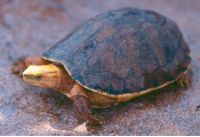
Captive Breeding of
McCordâs Box Turtle
Cuora mccordi ERNST, 1988
- by H. Artner -
Cuora mccordi was described as recently as 1988 on the basis of market/pet trade specimens. There are as yet no reports of the natural occurrence of this species. It may well be that it has already become extinct in its East Asian habitat. The life history of the species is therefore virtually unknown.
In 1995 the author purchased 1.1 C. mccordi via the pet trade. In 1996 another male and in 2000 a second female were obtained from private persons. The turtles are kept in a greenhouse all year long except during hibernation, which takes place in a cool basement room at about 8°C and lasts about three months. From February to the end of November all four specimens are kept in an enclosure measuring 165x75 cm with a deep layer of mixed sand and earth. The diet consists of home-made feeding gel, earthworms, banana and slugs. Mating takes place at dusk in spring and autumn, but single mating attempts have also been observed during summer. Up to three clutches are deposited per female in one season, each comprising 1 to 4 eggs. Incubation at 29°C lasts about 75 days, and at 27°C about 80 days. Hatchlings are raised on a diet consisting mostly of turtle feeding gel. So far (September 2005) 40 hatchlings have been produced, starting in 1999.
1. Introduction
The Asiatic turtle genus Cuora comprises nine species, all of which are confined to East and Southeast Asia. As a result of a critical degree of exploitation by humans for food and medical purposes, almost all these species are endangered.
In the last 15 years a number of new species in this genus have been described (SONG 1984; LUO & ZONG 1988; ERNST 1988; ZHAO 1990; McCORD & IVERSON 1991), among them C. mccordi. This was described by ERNST in 1988. Following information provided by a Hong Kong animal dealer, the native location of this type was given as the town of Boise in the province of Guangxi. The dealer later corrected his statement and claimed that the animals came from the nearby province of Yunnan. No specimens of C. mccordi have yet been found by professional herpetologists in the wild and it is therefore likely that the native location will need to be carefully checked.
Some experts even go so far as to cast doubt on the status of C. mccordi as a species, arguing that it could be a hybrid of Cuora flavomarginata and Cuora trifasciata. There are indeed a number of features which C. mccordi shares with both these other species, such as the almost identical plastron markings (in comparison with C. trifasciata) or the behaviour in captivity (the terrestrial way of life and the marked agility closely resemble C. flavomarginata, although C. flavomarginata is distinguished from C. mccordi in that it is primarily diurnal). Detailed ethological, morphological and genetic analysis will be required in order to clarify the species status of C. mccordi.
Many of the taxa within the genus Cuora are highly valued in traditional Chinese medicine, and the resulting sharp increase in the price of these species in the last 10 years has been felt even in Europe and the United States. These species are much sort after by reptile fanciers and astronomical sums are paid for individual specimens. This makes the continued breeding of these species â in particular C. aurocapitata, C. mccordi, C. pani and C. zhoui â all the more important. To date little has been reported of the breeding of C. pani and C. zhoui, both of which have been bred regularly only by occasional interested amateurs (ARTNER 1999, 2003; MEIER 2002). The publication of information about these breeding successes is the key to saving these species in private collections and in zoos from extinction. It is my hope that this report on C. mccordi can play a part in the attainment of this goal.
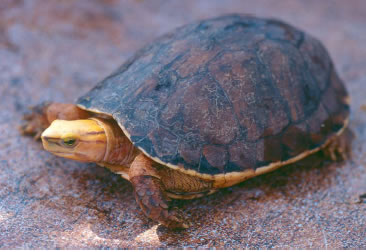
1.1 Systematics
Together with eight other recognized species, C. mccordi forms the genus Cuora, which belongs to the turtle family Geoemydidae. The taxa currently recognized within the genus are:
Cuora amboinensis (DAUDIN, 1802)
Cuora amboinensis amboinensis (DAUDIN, 1802)
Cuora amboinensis couro (SCHWEIGGER, 1812)
Cuora amboinensis kamaroma RUMMLER & FRITZ, 1991
Cuora amboinensis lineata McCORD & PHILIPPEN, 1998
Cuora aurocapitata LUO & ZONG, 1988
Cuora flavomarginata (GRAY, 1863)
Cuora flavomarginata flavomarginata (GRAY, 1863)
Cuora flavomarginata evelynae ERNST & LOVICH, 1990
Cuora flavomarginata sinensis (HSÃ, 1930)
Cuora galbinifrons BOURRET, 1939
Cuora galbinifrons galbinifrons BOURRET, 1939
Cuora galbinifrons bourreti OBST & REIMANN, 1994
Cuora galbinifrons picturata LEHR, FRITZ & OBST, 1998
Cuora mccordi ERNST, 1988
Cuora pani SONG, 1984
Cuora trifasciata (BELL, 1825)
Cuora yunnanensis (BOULENGER, 1906)
Cuora zhoui ZHAO, ZHOU & YE in ZHAO, 1990
Newly published studies (De BRUIN & ARTNER 1997; PARHAM et al. 2001) have shown that the forms described as C. hainanensis and C. galbinifrons serrata are invalid.
1.2 Description
The carapace of Cuora mccordi is an elongated oval, which in male specimens in particular is somewhat flattened. Females have a relatively highly domed shell. The basic colour is a uniform reddish brown. The plastron, which is notched at the rear, is primarily black with lighter yellow areas on the periphery (similar to C. trifasciata). The underside of the edge scutes is yellow. Characteristic of the genus is a hinge which runs across the plastron between the pectoral and abdominal scutes and enables the plastron to be closed completely.
The head is narrow and extends to a pointed snout. It is predominantly yellow, and on either side a yellow stripe bordered on both sides in black runs from the mouth over the eye towards the rear. The iris of the eyes is a yellowish green. The front extremities are predominantly reddish brown, while the rear ones are yellowish in colour.
According to my observations males achieve a maximum carapace length of 14 cm, while females can be up to 16 cm long. Other features which distinguish the sexes are the tail, which in males is longer and thicker at the base, with a more distally located cloacal opening, and the significantly higher domed carapace of the female.
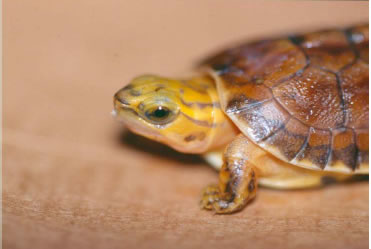
1.3 Observations in the wild
Although nearly 15 years have passed since Cuora mccordi was first described, it remains the case that not one report of studies in the wild has yet been published. The exact location of the animalâs natural territory is not even known for certain. This is most remarkable and leads to the question of whether or not C. mccordi is in fact an independent taxon occurring in the wild. Further results must be awaited.
1.4 Distribution
According to ERNST (1988) Cuora mccordi occurs in the west of the southern Chinese province of Guangxi (in the vicinity of the town of Boise). According to McCORD & IVERSON (1991) the reptile dealer in Hong Kong who supplied the first specimens later maintained, however, that the place where they were found actually lies further to the west, in the province of Yunnan.
In the course of an expedition of several weeksâ duration in the Chinese provinces of Guangxi and Yunnan, the author was unable to find any evidence of the occurrence of C. mccordi, nor any person who could identify the species from photographs carried by the expedition.
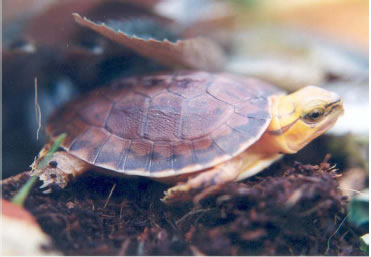
2. Materials and methods
2.1 Breeding group
The two adult males and two adult females of the breeding group were acquired between 1995 and 2000.
Table 1: Size (mm) and weight (g) of the breeding group (as at: 11/02)
Animal
Carapace length Weight
Male 1 141.1 352
Male 2 134.0 362
Female 1 157.4 508
Female 2 153.6 441
Both females are now breeding annually. Table 1 gives the size and weight of all the animals in the breeding group.
2.2 Accommodation
2.2.1 Terraria
From the beginning of February until the beginning of November all four adult specimens are kept in a terrarium on the floor of a large greenhouse, separated entirely from other species. The terrarium measures 165 x 65 x 55 cm (l x w x h).
A large Ficus benjamina is planted on the south side of the terrarium and this almost completely blocks direct sunlight. The floor consists of a mixture of garden soil and fine-grained sand, forming a layer about 20 cm deep. The front wall is made of breeze blocks, the two sides are of wood and the rear wall is made of sheets of Styrodur, which provide direct insulation for the heating pipes located immediately behind the terrarium. A large piece of cork bark in the shape of a half-pipe serves as a hiding place, and a dish 35 cm in diameter and 5 cm deep provides a water basin. From around the beginning of November until the beginning of February the animals are overwintered at a temperature of 4 -10°C in 90-litre mortar tubs which are placed in a very humid basement room and filled with a mixture of coconut fibres and garden soil which is always kept moist.
2.2.2 Lighting
The area is lit entirely by natural sunlight. The greenhouse roof has a UV permeability of 80%, which is more than sufficient.
2.2.3 Heating, shade and ventilation
The whole greenhouse is heated by heaters mounted on the two long sides. The air temperature in winter never falls below 8 °C, while in summer it rarely exceeds 32°C (although short-term rises in temperature to over 40°C have been recorded). Automatic ventilation and shading equipment, controlled by a temperature sensor, helps to prevent overheating (see also ARTNER 2001).
2.3 Feeding
The adult Cuora mccordi are fed two or three times a week with a homemade turtle gel (ARTNER 1995; 1998) and occasionally with earthworms, slugs and bananas. The quantity of food given is that which is eaten in 10 to 15 minutes. After that time, any food remnants which remain are promptly removed from the basin.
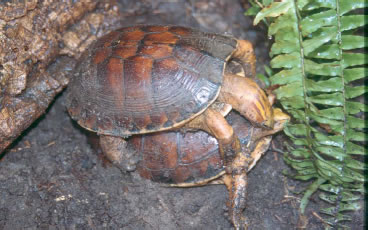
... read the whole article in our EMYS magazine, for members only!
- Become a member -
Za sadržaj svakog komentara je odgovoran autor tog komentara.
| Autor | Thread |
|---|